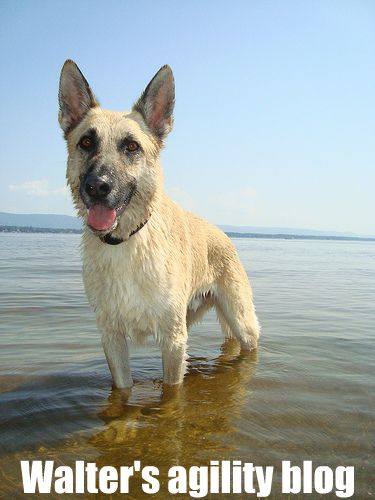I've been really interested in learning something about dog structure lately, so no way could I pass up the chance to attend Chris Zink's "Coaching the Canine Athlete" seminar, less than an hour's drive away. Originally had an auditing spot but figured what the heck, upgraded to a working spot. Oh, and it's held at a new place we'll be trialing at this winter, so a side bonus is being able to give Lucy and Walter treats all over the arena :) Walter got to be the worker today and I'll probably work Lucy tomorrow.
Though the entry fee wasn't cheap, I feel like I got my money's worth after only today.
We received a packet of several articles she's written, which will be neat to read later. Took 10 pages of notes today alone. There were lots of videos and photos as part of the presentation.
Here are some of the topics she discussed: ectomorphic vs endomorphic vs mesomorphic; effects of spaying/neutering before puberty; weight to height ratio; rear angulation; front angulation; dewclaws; a bunch of stuff about all the gaits; exercises to teach a dog to trot instead of pace; effect of different body types and performances on the dogwalk, a-frame, weaves, teeter, and jumps.
My favourite part was learning about front and rear angulation. I'd heard these terms before and tried googling about it once or twice but couldn't really find anything that helped explain it. If I understood correctly, more rear angulation means less stability, less ability to turn efficiently, whereas less rear angulation leads to more stability, better ability to turn efficiently, but also more stress on the legs, increased chance of CCL rupture. Something in the moderate range is good for agility dogs. As for shoulder angulation, I can't remember what effects it has, but crappy rear angulation is much preferred over crappy front angulation. Like most GSDs, Walter has "wonderful" shoulder angulation, woo hoo! His rear angulation is maybe the high side of moderate (from what I saw comparing him with today's other canine participants), but nothing too exagerated. Of the dogs in our little working group (which included a golden, sheltie, JRT, malinois, and ACD), Walter had the most shoulder angulation (good) and the second most rear angulation (not so good). I had a look at Lucy afterward and was surprised to see that it looks to me (not that I'm any expert after just one day of learning about it) like she has quite a straight shoulder, at least compared to Walter. But her rear angulation is nicely moderate.
Another interesting bit was the discussion about the weight to height ratio. Walter's is 2.5, Lucy's is 2.2. A general rule of thumb is that anything greater than 3.5 is in the danger zone; 2.0-3.5 means you should be careful, take care to run on only good footing, limit how many full height jumps they do, and so on; <2.0 is easy street. I'm glad both dogs are toward the low side of the middle range, especially since I thought Walter would be higher up on the scale.
Chris is a big proponent of not spaying or neutering before puberty. Lucy wasn't spayed until after her first heat, but only because the shelter didn't know if she had been spayed or not. The day after I brought her home, she went into heat. Walter on the other hand was neutered right around 6 months. That was just The Way Things Are Done as far as I knew back then. Food for thought about what to do for a future dog, although probably s/he won't be a puppy, so someone else will have made that decision.
Learned today that pacing is neither a natural nor a healthy gait for dogs. Just my luck that both my current dogs and my old childhood dog are/were all pacers. Actually, not luck so much as me inadvertently teaching them to do that, which she suggests is the main reason why some / a lot of dogs pace. Learned an exercise using pvc poles as cavaletti to teach the dog to trot instead of pace. Also she showed a neat way involving footwork (by the human) to encourage dogs to trot instead of pace. A very handsome big dobie did a great job of demonstrating these.
My least favourite part of the day was where we had to get our dog to trot by our side for about 70 feet while everyone else watched. Sounds easy? Well, it wasn't so easy for many of us, and she seemed a bit impatient with our shortcomings as handlers. We had to get our dog to trot as fast as they can without breaking into a canter, all the while not looking at the dog, but also at the same time looking at them out of the corner of our eye so we could sort of see what they were doing. I was first up on this exercise and Walter was being goofy, kept jumping up at me and biting at his leash. Anyway eventually he settled down and got the job done. Lots of others had problems too - handler looking at dog, dog pacing, dog cantering, dog giving too much heads-up attention, handler not keeping up with dog, and so on. If I had one suggestion for improving the seminar, it would be for her to be a bit easier on us for this exercise. She seemed to be a bit impatient, and her impatience seemed to be stressing some of the people out. I was glad to have gone first, otherwise watching everyone else getting stressed out may have resulted in me dreading my turn and wishing I had audited instead ;)
But the rest was great!
Looking forward to more information overload tomorrow.
Subscribe to:
Post Comments (Atom)

No comments:
Post a Comment